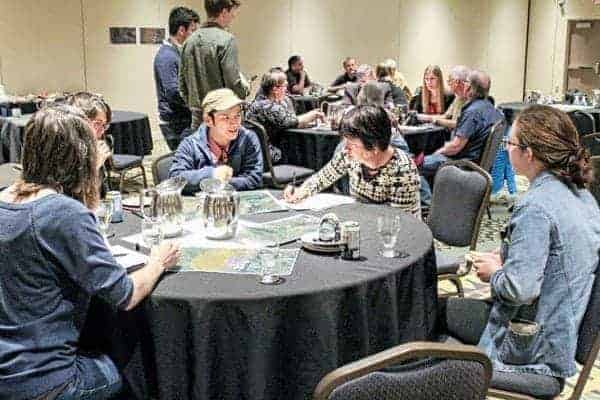The governments of Northwest Territories and Canada want to know how people use the land and lakes around Yellowknife, Ndilo and Dettah to get a better understanding of people's exposure to contaminants left behind by activities at Giant and Con mines.
Contamination of the soil, water and wildlife beyond the boundaries of the mines is of SA����Ӱ�Ӵ�ý�high interest and concern to the public,SA����Ӱ�Ӵ�ý� Lisa Dyer, director of Environment at the GNWT's department of Environment and Natural Resources, said at a public meeting on Thursday.

As part of a human health risk assessment, researchers are gathering information about recreational activities on a fan-shaped swath of land and water up to 25 kilometres west and northwest of Giant Mine, as well as east of Dettah.
They hope fishers, swimmers, campers and cabin-dwellers will participate in the study, which will help determine whether people are being exposed to arsenic, antimony and mercury at unhealthy levels.
SA����Ӱ�Ӵ�ý�We're trying to understand how people are exposed to contaminants or arsenic in the environment, so to be able to understand how people are exposed, we need to understand how they use certain resources,SA����Ӱ�Ӵ�ý� said Dyer.
SA����Ӱ�Ӵ�ý�We really need to understand how people use the area to be able to come up with scenarios that suggest where their exposure might be and then, based upon that, we might understand the level of risk.SA����Ӱ�Ӵ�ý�
There is limited data on contaminants in fish from inland lakes (the lakes near Great Slave Lake) and on the water and sediment quality in areas close to town where people have cabins.
The human health risk assessment will help fill those gaps.
A number of studies have already been done on chemical levels in water, plants, soil, wildlife and country foods from around the Giant Mine site.
This assessment is looking at contaminants further afield, in an area referred to as the SA����Ӱ�Ӵ�ý�stack shadow.SA����Ӱ�Ӵ�ý�
The stack shadow covers land and lakes downwind from Giant Mine, and includes Long, Lower Martin, Martin, Vee, Ryan and Walsh lakes.
Banting, Prosperous, River, Prelude and Pontoon lakes have been brought into the study because people have cabins on these lakes.
The GNWT has hired environmental consulting firm Canada North Environmental Services (CanNorth), which is wholly-owned by the Lac La Ronge Indian Band in Saskatchewan, to carry out the study, at a cost of $100,000.
Researchers want to find out what areas outside of town people go to, how long they spend in those places, and what activities they do while they are there.
SA����Ӱ�Ӵ�ý�Maybe you just hike for a few hours, maybe you go and you camp there and you spend several days there SA����Ӱ�Ӵ�ý� those are the sorts of questions we'd like to get some information from,SA����Ӱ�Ӵ�ý� Harriet Phillips, CanNorth's risk assessment division manager, said during the public engagement session Thursday.
Phillips's team also wants to know if people fish, hunt and swim in the assessment area, and how often they do so.
Arsenic and antimony contamination are the study's primary focus, but researchers are also looking at and mercury levels.
Phillips said some of the inland lakes have higher mercury levels, which is possibly due to sulfate emissions from Giant Mine's roaster from the time it was operating.
That heavy metal, said Phillips, SA����Ӱ�Ӵ�ý�accumulates in fish and people eat fish, and so we want to see if there are elevated mercury levels there and what that means.SA����Ӱ�Ӵ�ý�
Kieron Testart, MLA for Kam Lake, attended the public meeting. He said the government takes contamination SA����Ӱ�Ӵ�ý�very seriously.SA����Ӱ�Ӵ�ý�
Testart expressed some concern over how the researchers are gathering their information.
SA����Ӱ�Ӵ�ý�If they're relying on online questionnaires and this meeting tonight, we're not going to get all the information we need,SA����Ӱ�Ӵ�ý� he said.
SA����Ӱ�Ӵ�ý�I really hope the department is going to go out along the Ingraham Trail and go door-to-door with this.SA����Ӱ�Ӵ�ý�
Isabel Wilson, a student at McGill University in Montreal, came to the meeting with her mother.
Wilson often swims in the lakes in the summer, but is not really concerned about contamination.
She said she doesn't plan on changing her outdoor activity unless new information reveals SA����Ӱ�Ӵ�ý�there's more contamination in areas that I didn't think there was so much.SA����Ӱ�Ӵ�ý�
The human health risk assessment is expected to wrap up before March 31, 2019.
Residents can share their activities on the lands and waters around Yellowknife by completing an online survey at: www.enr.gov.nt.ca/en/services/have-your-say-legacy-arsenic-contamination-around-yellowknife


